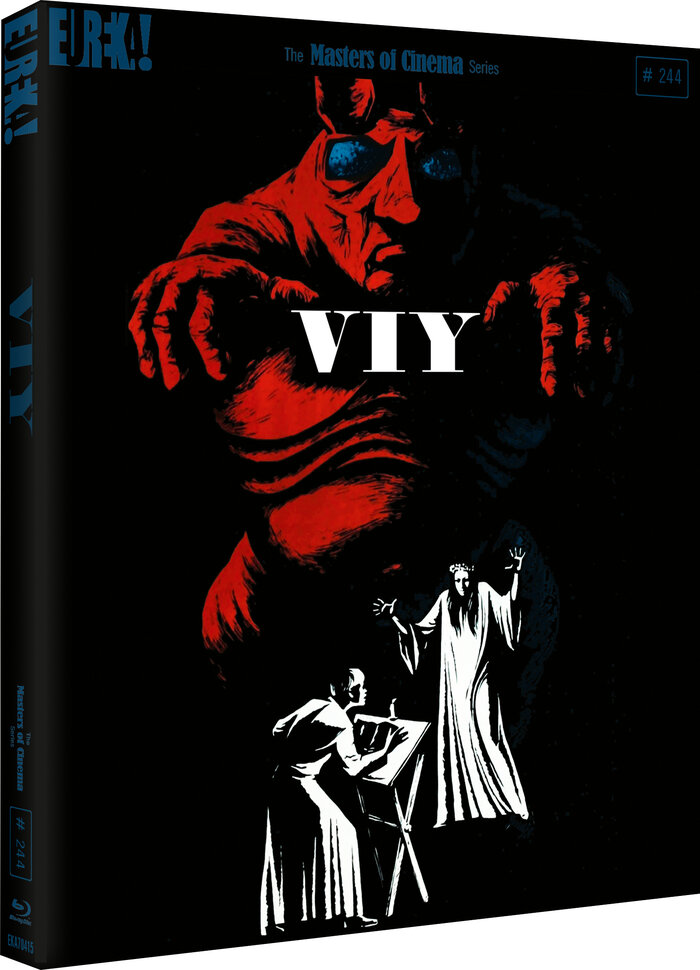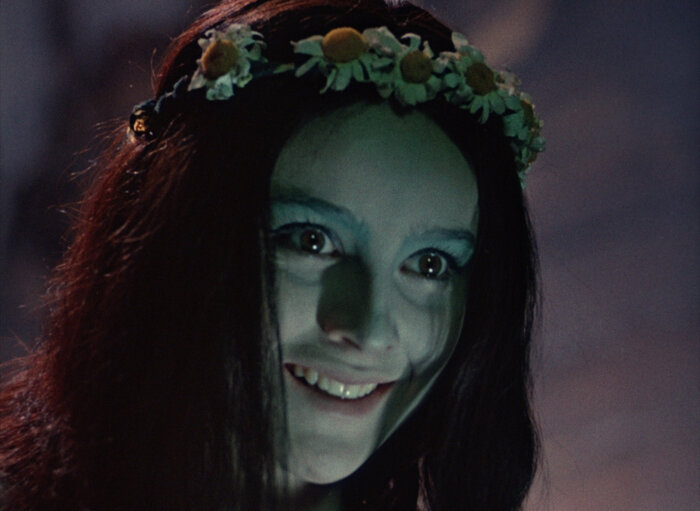Released in 1967, Viy (Вий) was the first horror film to be produced in the USSR. Based on a novella by Gogol that draws from a multitude of folkloric tropes, Viy is more disquieting than chilling, though several sequences still unnerve. Konstantin Yershov and Georgi Kropachyov are credited as directors, but screenwriter and art director Aleksandr Ptushko was the film’s guiding spirit. Underappreciated in the West, Ptushko was a pioneer in the field of stop-motion animation; start looking for examples of his work on YouTube and you’ll see some astounding clips. Think of him as a Soviet-era Willis O’Brien or Ray Harryhausen.
 Viy opens with a crowd of rowdy seminary students being sent home for the holidays. This being remote pre-revolutionary Russia, three of them take a wrong turn and ask an old lady if they can spend the night in her rundown farmhouse. Leonid Kuravlyov’s Khoma, terrified by her sexual advances, is bewitched and lets her ride him like a horse, the pair soon flying through the air. Khoma beats her viciously upon landing, shocked to see her transform into a young woman. Returning to the seminary, he’s forced by the rector to travel to a remote village and pray for the dying daughter of a rich merchant. Who, of course, turns out to be the witch he attacked, and for three nights he is locked into the creaky village chapel with her coffin for company.
Viy opens with a crowd of rowdy seminary students being sent home for the holidays. This being remote pre-revolutionary Russia, three of them take a wrong turn and ask an old lady if they can spend the night in her rundown farmhouse. Leonid Kuravlyov’s Khoma, terrified by her sexual advances, is bewitched and lets her ride him like a horse, the pair soon flying through the air. Khoma beats her viciously upon landing, shocked to see her transform into a young woman. Returning to the seminary, he’s forced by the rector to travel to a remote village and pray for the dying daughter of a rich merchant. Who, of course, turns out to be the witch he attacked, and for three nights he is locked into the creaky village chapel with her coffin for company.
The fun starts here, with Khoma assailed by increasingly threatening supernatural forces and the girl, Pannochka (Natalya Varley, pictured below), stepping out of her coffin to torment him, Khoma cowering inside a chalk circle he’s drawn for protection. Each vigil is progressively scarier, and the now white-haired Khoma’s attempts to flee are doomed.
The third night contains the sequences for which Viy is most famous, the inventive visual effects achieved through a combination of techniques. Giant hands, walking skeletons, vampires and werewolves strut their stuff and the titular demon is summoned. The results are still unsettling, Ptushko’s fast-moving camera swirling around the chapel to dizzying effect.
 Folk-horror elements aside, Viy convinces as an accurate portrayal of harsh rural life. Vodka accompanies every human exchange, the dirt and squalor anticipating the grubbiness of Terry Gilliam’s striking debut, Jabberwocky. Kuravlyov is excellent in the lead role, the most unholy holy man imaginable, and a throwaway exchange where he reveals that he never knew his parents has us rooting for him. There’s not a wasted second, the whole thing lasting just short of 80 minutes.
Folk-horror elements aside, Viy convinces as an accurate portrayal of harsh rural life. Vodka accompanies every human exchange, the dirt and squalor anticipating the grubbiness of Terry Gilliam’s striking debut, Jabberwocky. Kuravlyov is excellent in the lead role, the most unholy holy man imaginable, and a throwaway exchange where he reveals that he never knew his parents has us rooting for him. There’s not a wasted second, the whole thing lasting just short of 80 minutes.
Eureka’s two-disc package includes A Holy Place, a 1990 adaptation of the same story made by Serbian director Djordje Kadijevic. Though atmospheric and well acted, it can’t compete with the stripped-down original. Extras include tantalising extracts from silent Russian horror films and a vintage Soviet-era documentary on Gogol. Michael Brooke’s commentary is interesting, revealing that it was hard to find convincing rural locations in an age of industrialised farming, and how professional gymnasts and specially trained cats contributed to key scenes.















Add comment